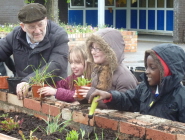A total of 16 schools and community groups have been working hard to cultivate their own living history of the city, with plants identified as having been brought to Bristol in the ballast holds of sailing vessels when Bristol was a major European port.
Unusual plant species - with names such as Squirting Cucumber and Love in the Mist - were transported as ‘incidental cargo’ between the 18th and early 20th century.
They will now thrive in Ballast Seed Gardens across the city, which have been created as part of the Seeds of Change: Growing a Living History of Bristol project led by the University of Bristol to encourage people to learn about the city’s trade and maritime past. It’s supported by a £38,500 grant from the Heritage Lottery Fund.
Over 500 pupils from 11 schools are involved in the project, which sees 28 student volunteers from the University work with them to plant the gardens and explore links with science, citizenship, art, history and geography.
A further five community groups from Bristol are also involved, including a diverse range of people from Knowle West who are helping to create a brick horseshoe-shaped planter at The Park.
Community project Youth Moves has brought together a blend of local people and groups. Students and parents from Knowle Park Primary School have been working alongside adults from the Filwood Chase history group and young adults from Silva Care who have learning difficulties. Buried Treasure, a not-for-profit organic gardening organisation, propagated the plants from seed.
Students based at The Park, who are currently working towards their construction qualifications, also showed an interest in building something new that could be used and enjoyed by everyone in their local community, instead of building projects in the workshop that normally have to be knocked down once they have been completed.
Construction student James Maddocks successfully applied for funding through Bristol City Council’s ‘Transformers’ project, which offers young people funding to improve their local community, and it paid for the materials used to build the brick planter.
Ben Carpenter, from Youth Moves has been heading up the project and said: “It has been a pleasure to deliver a project with a variety of local people from different groups, aged from eight to 80.
“All the groups have learnt or passed on something new such as bricklaying, insights into Bristol’s rich maritime history or gardening skills. Everyone has also met someone new from a different generation of their community whilst getting their hands dirty planting, having lunch or enjoying local green spaces.
“Lots of other people from this community will also feel the benefit of this project when they sit down on the benches inside the planter and have a chat or eat their lunch. Whether local people have been part of the Seeds of Change project or are enjoying the results of it, this will definitely help improve community spirit as a whole.”
Martha Crean, Seeds of Change Coordinator at the University of Bristol, said: “This project has really captured everyone’s imagination and it’s wonderful to see these gardens growing across the city. It’s a great chance to get people together and to share experiences of living in Bristol and exploring the connections and journeys that link us to the history of our port city.”
Many ballast seeds have already been cultivated and grown to create a Floating Ballast Seed Garden using a disused grain barge, which is currently moored alongside Castle Park.
The public artwork has been developed as part of the Seeds of Change project which was conceived by Brazilian artist Maria Thereza Alves as part of the 2007 Arnolfini exhibition Port City. Bristol City Council and Bristol University’s Botanic Garden have since worked with the artist and Arnolfini to develop the project.
For further information about Seeds of Change: Growing a Living History of Bristol, see www.bristol.ac.uk/seeds-of-change

